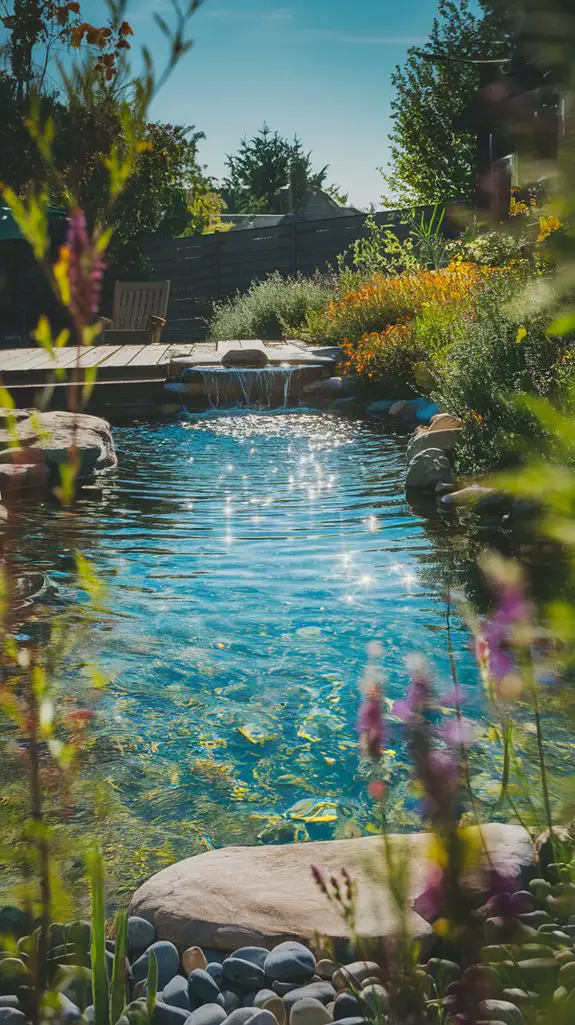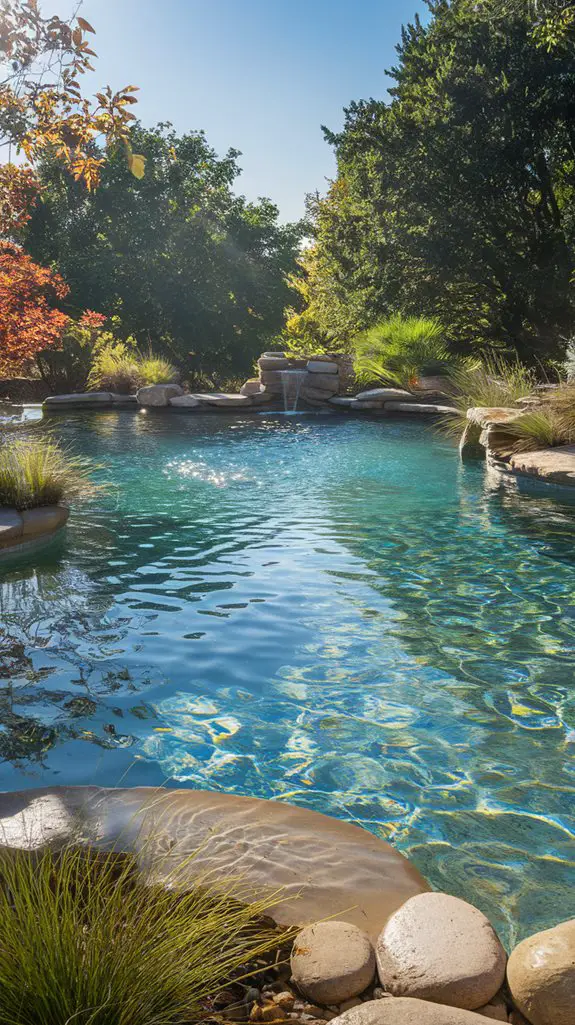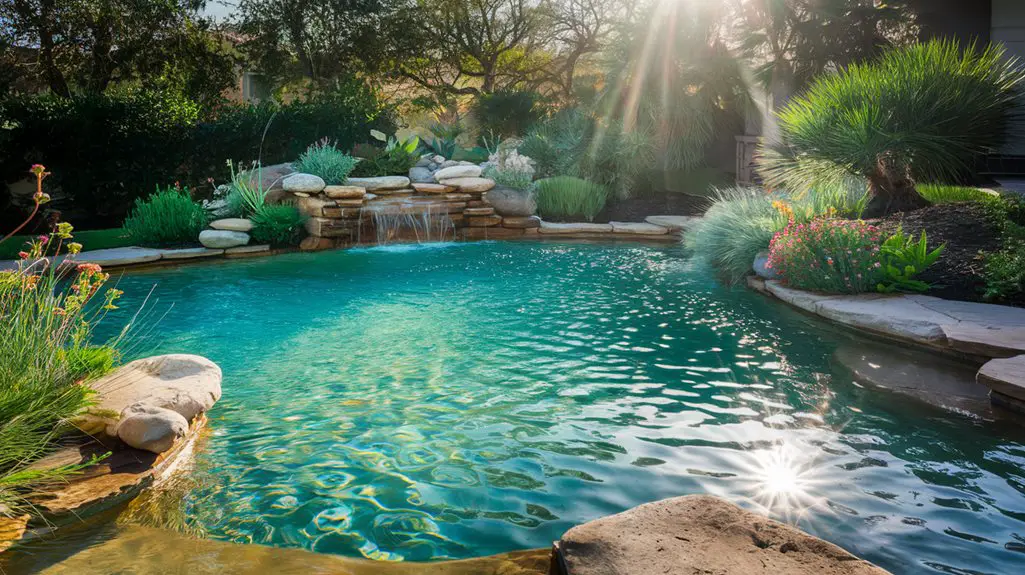Natural swimming pools for backyards offer a unique blend of aesthetics and sustainability. They provide a chemical-free swimming experience, relying instead on plants and microorganisms for water clarity. These pools not only enhance your landscape but also support local wildlife. If you're considering an eco-friendly alternative to traditional pools, understanding their design and functionality is essential. What might this mean for your outdoor space?
What Is a Natural Swimming Pool?
A natural swimming pool, often referred to as a swimming pond, combines the beauty of nature with the functionality of a traditional pool. Instead of relying on chemicals, these pools use a biological filtration system, featuring plants and microorganisms to keep the water clean.
You'll appreciate the aesthetic appeal, as the design seamlessly integrates into your landscape, creating a tranquil environment. The swimming area is typically separated from the regeneration zone, where aquatic plants thrive, providing natural filtration.
This eco-friendly option not only conserves water but also promotes biodiversity in your backyard. As you swim, you'll experience the invigorating feel of nature while enjoying a low-maintenance pool that enhances your outdoor space sustainably.
Benefits of Natural Swimming Pools
Numerous benefits come with choosing a natural swimming pool for your backyard.
You'll enjoy a chemical-free swimming experience, as these pools use biological filtration and plants to maintain water quality. This means healthier water for you and your family, reducing skin irritations and allergies often caused by traditional chlorine pools.
Additionally, natural pools blend seamlessly into the landscape, enhancing your home's aesthetic appeal while promoting biodiversity. The ecosystem created supports wildlife, transforming your backyard into a vibrant habitat.
Maintenance is simpler, requiring fewer resources and lower energy consumption compared to conventional pools. Plus, you'll save on long-term costs, as natural pools typically have lower operational expenses.
Embrace sustainability and enjoy a revitalizing swim while protecting the environment.
How Natural Swimming Pools Work

While many people are accustomed to the traditional chlorine pool system, understanding how natural swimming pools work reveals a fascinating alternative that prioritizes both water quality and ecological balance.
These pools utilize a biological filtration system, incorporating a shallow regeneration zone filled with aquatic plants and gravel. The plants naturally filter impurities and provide oxygen, creating a self-sustaining ecosystem.
Water circulates through this zone, allowing beneficial bacteria to break down organic matter. You'll find that the absence of harsh chemicals not only promotes a healthier swimming environment but also encourages biodiversity.
The result is crystal-clear water that mimics a natural pond, offering you a serene swimming experience while harmonizing with the environment.
Design Elements of Natural Swimming Pools
Natural swimming pools not only offer a healthier swimming environment but also present unique opportunities for creative design. You can incorporate natural materials like stone and wood to blend your pool seamlessly into the landscape.
Consider adding aquatic plants to enhance filtration and aesthetics—species like water lilies and cattails not only beautify but also promote biodiversity.
Think about varying depths and shapes; a freeform design can mimic a natural pond, while shallow areas invite lounging.
Adding features like waterfalls or rock formations not only creates visual interest but also aids in water circulation.
Lighting plays an essential role, too—subtle, energy-efficient options can enhance the ambience at night.
With careful planning, your natural swimming pool can become a stunning focal point in your backyard.
Maintenance Requirements for Natural Swimming Pools

Maintaining a natural swimming pool requires a balanced approach, guaranteeing both the ecosystem thrives and the water remains clean and inviting.
You'll need to monitor water quality regularly, checking pH and nutrient levels to support healthy aquatic life. Skimming debris and leaves from the surface helps prevent algae growth, while occasional vacuuming of the pool floor keeps it pristine.
You should also manage plant life in the regeneration zone, trimming overgrown vegetation to maintain balance and prevent overcrowding.
Regularly inspecting and cleaning the filtration system guarantees peak water circulation.
Cost Considerations for Installing a Natural Swimming Pool
Installing a natural swimming pool involves various cost considerations that can markedly impact your budget.
First, the initial investment can range from $30,000 to $60,000, depending on size, materials, and design complexity. You'll need to account for excavation, filtration systems, and plant selection, which can greatly influence the overall cost.
Additionally, consider ongoing expenses like water quality maintenance and potential landscaping. While these pools may have a higher upfront cost compared to traditional ones, they often require less chemical maintenance, making them more sustainable in the long run.
Finally, check local regulations and permits, as these can add unexpected costs. By planning carefully, you can create a beautiful, eco-friendly oasis that fits your financial parameters.
Popular Plants and Wildlife in Natural Swimming Pools
While envisioning a serene backyard oasis, it's essential to contemplate the vibrant plants and wildlife that thrive in natural swimming pools. Incorporating native aquatic plants like water lilies, cattails, and rushes not only enhances aesthetics but also supports water quality. These plants filter impurities, providing a balanced ecosystem.
You might also attract fascinating wildlife, such as dragonflies, frogs, and various birds, which will delight you with their presence.
Consider creating zones for both submerged and emergent plants to encourage biodiversity. Installing a rock or gravel edge can offer habitats for beneficial organisms, further enriching the ecosystem.
Conclusion
To sum up, natural swimming pools offer a stunning, eco-friendly alternative to traditional pools, enhancing your backyard while supporting local ecosystems. You might worry about maintenance, but these pools are surprisingly low-maintenance once established, relying on nature's processes to keep water clear. By choosing a natural swimming pool, you're not just creating a personal oasis; you're investing in a sustainable environment that benefits both you and the wildlife around you. Immerse yourself and embrace this harmonious approach to swimming!




